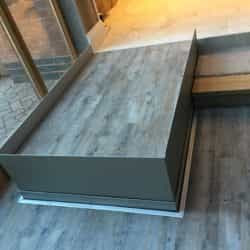When I was first diagnosed with Fibromyalgia I often had to resort to using a manual wheelchair. I found it fascinating and a little disturbing how being in the wheelchair affected my sense of self worth and independence. Even having the ability to communicate clearly with whoever was pushing me I was frustrated with not being able to go exactly where I wanted to be.
Even after all these years on the days I concede to my condition and use the chair my husband in particular has not got over the habit of treating me like a car, parking me neatly facing walls or angling me away from the item in the store I want to examine.
Shop assistants mostly speak to him even though I'm the one holding out my debit card and in many shops I can't navigate through closely located stands. Getting upstairs always seems to involve making our way to the farthest point in the shop hunting for a lift, then waiting until there's room to get in one. Thats assuming there is a lift at all.
At home when I'm in flare up I usually choose a floor - upstairs or downstairs- and stay there. With a chronic pain and fatigue condition like mine even though I can physically walk, tackling steps can leave me too exhausted to even make a drink or do anything but rest.
Sadly with increasing numbers of people reporting Long Covid symptoms which leave many unable to live their normal active life, I think more and more people will become reliant on aids like manual and powered chairs and other aids to help them cope.
Add to that the vast group of people with physical disabilities and it makes you wonder how many struggle at homes which are not designed for those unable to cope with stairs.
Thankfully old-style stair-lifts are not the only option available to people who want to remain independent in their own homes. I have recently seen adverts for disabled access lifts which are a rather more attractive and convenient way of providing improved access in multi-storey homes or even homes with multi-level rooms.
Having struggled with portable ramps in a multi-level room in a holiday cottage where I was sharing a room with a wheelchair user I was particularly impressed to learn of a very clever design of "flex step" stairs which convert quickly and easily to a platform lift then back to stairs which suit the aesthetic of the room. You can even get some "hidden step" designs where a section of floor rises up electronically to assist people needing to travel short distances upwards. They can be used indoors and out and take up much less space than a traditional lift.
Although my room mate no doubt enjoyed the precarious and steep thrill-ride to the breakfast table each morning (the cottage owners had not previously tested the ramp with an actual wheelchair) I'm sure she would have much preferred a more dignified and safe ascent and descent between the two levels in the room.
Our house is not enormous but with the increasingly cleverly designed solutions ranging from the hidden step to enclosed lifts taking up very little space it is comforting to know that even if I find myself increasingly unable to walk up and. down stairs I will still be able to stay in the family home where I raised our seven children.

